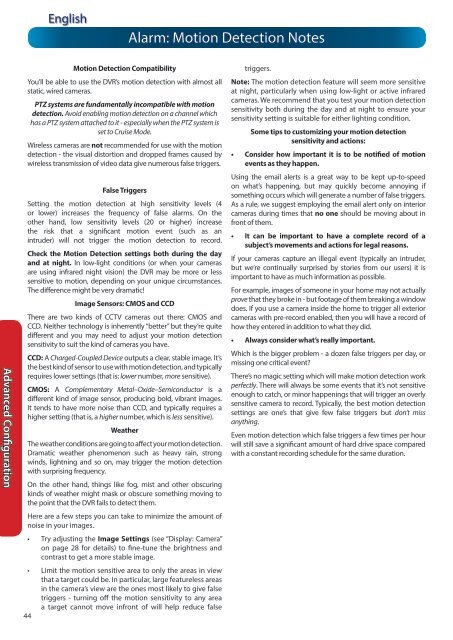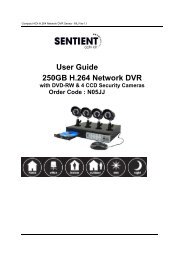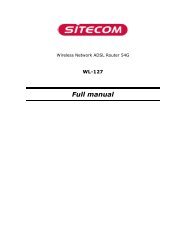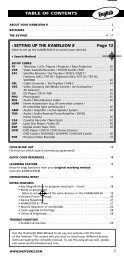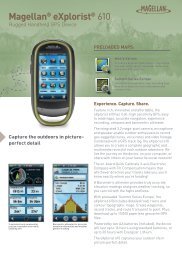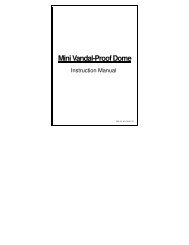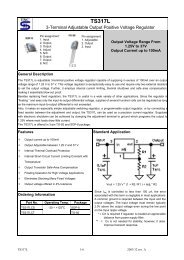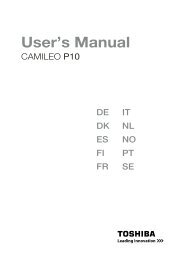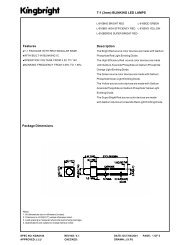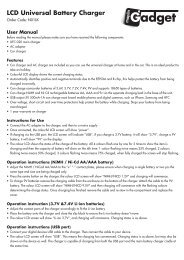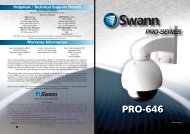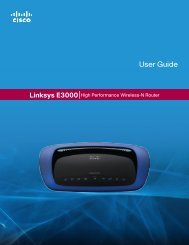N57QK_manual.pdf filesize - Maplin Electronics
N57QK_manual.pdf filesize - Maplin Electronics
N57QK_manual.pdf filesize - Maplin Electronics
You also want an ePaper? Increase the reach of your titles
YUMPU automatically turns print PDFs into web optimized ePapers that Google loves.
Advanced Configuration<br />
English<br />
Motion Detection Compatibility<br />
You’ll be able to use the DVR’s motion detection with almost all<br />
static, wired cameras.<br />
PTZ systems are fundamentally incompatible with motion<br />
detection. Avoid enabling motion detection on a channel which<br />
has a PTZ system attached to it - especially when the PTZ system is<br />
set to Cruise Mode.<br />
Wireless cameras are not recommended for use with the motion<br />
detection - the visual distortion and dropped frames caused by<br />
wireless transmission of video data give numerous false triggers.<br />
False Triggers<br />
Setting the motion detection at high sensitivity levels (4<br />
or lower) increases the frequency of false alarms. On the<br />
other hand, low sensitivity levels (20 or higher) increase<br />
the risk that a significant motion event (such as an<br />
intruder) will not trigger the motion detection to record.<br />
Check the Motion Detection settings both during the day<br />
and at night. In low-light conditions (or when your cameras<br />
are using infrared night vision) the DVR may be more or less<br />
sensitive to motion, depending on your unique circumstances.<br />
The difference might be very dramatic!<br />
Image Sensors: CMOS and CCD<br />
There are two kinds of CCTV cameras out there: CMOS and<br />
CCD. Neither technology is inherrently “better” but they’re quite<br />
different and you may need to adjust your motion detection<br />
sensitivity to suit the kind of cameras you have.<br />
CCD: A Charged-Coupled Device outputs a clear, stable image. It’s<br />
the best kind of sensor to use with motion detection, and typically<br />
requires lower settings (that is: lower number, more sensitive).<br />
CMOS: A Complementary Metal–Oxide–Semiconductor is a<br />
different kind of image sensor, producing bold, vibrant images.<br />
It tends to have more noise than CCD, and typically requires a<br />
higher setting (that is, a higher number, which is less sensitive).<br />
Weather<br />
The weather conditions are going to affect your motion detection.<br />
Dramatic weather phenomenon such as heavy rain, strong<br />
winds, lightning and so on, may trigger the motion detection<br />
with surprising frequency.<br />
On the other hand, things like fog, mist and other obscuring<br />
kinds of weather might mask or obscure something moving to<br />
the point that the DVR fails to detect them.<br />
Here are a few steps you can take to minimize the amount of<br />
noise in your images.<br />
• Try adjusting the Image Settings (see “Display: Camera”<br />
on page 28 for details) to fine-tune the brightness and<br />
contrast to get a more stable image.<br />
• Limit the motion sensitive area to only the areas in view<br />
that a target could be. In particular, large featureless areas<br />
in the camera’s view are the ones most likely to give false<br />
triggers - turning off the motion sensitivity to any area<br />
a target cannot move infront of will help reduce false<br />
44<br />
Alarm: Motion Detection Notes<br />
triggers.<br />
Note: The motion detection feature will seem more sensitive<br />
at night, particularly when using low-light or active infrared<br />
cameras. We recommend that you test your motion detection<br />
sensitivity both during the day and at night to ensure your<br />
sensitivity setting is suitable for either lighting condition.<br />
Some tips to customizing your motion detection<br />
sensitivity and actions:<br />
• Consider how important it is to be notified of motion<br />
events as they happen.<br />
Using the email alerts is a great way to be kept up-to-speed<br />
on what’s happening, but may quickly become annoying if<br />
something occurs which will generate a number of false triggers.<br />
As a rule, we suggest employing the email alert only on interior<br />
cameras during times that no one should be moving about in<br />
front of them.<br />
• It can be important to have a complete record of a<br />
subject’s movements and actions for legal reasons.<br />
If your cameras capture an illegal event (typically an intruder,<br />
but we’re continually surprised by stories from our users) it is<br />
important to have as much information as possible.<br />
For example, images of someone in your home may not actually<br />
prove that they broke in - but footage of them breaking a window<br />
does. If you use a camera inside the home to trigger all exterior<br />
cameras with pre-record enabled, then you will have a record of<br />
how they entered in addition to what they did.<br />
• Always consider what’s really important.<br />
Which is the bigger problem - a dozen false triggers per day, or<br />
missing one critical event?<br />
There’s no magic setting which will make motion detection work<br />
perfectly. There will always be some events that it’s not sensitive<br />
enough to catch, or minor happenings that will trigger an overly<br />
sensitive camera to record. Typically, the best motion detection<br />
settings are one’s that give few false triggers but don’t miss<br />
anything.<br />
Even motion detection which false triggers a few times per hour<br />
will still save a significant amount of hard drive space compared<br />
with a constant recording schedule for the same duration.


